When it comes to BBQ, brisket is king! And what barbecue aficionados won’t tell you is you can make an amazing fork-tender oven-baked brisket with a flavorful, crunchy bark using your home oven, no smoker or grill necessary.
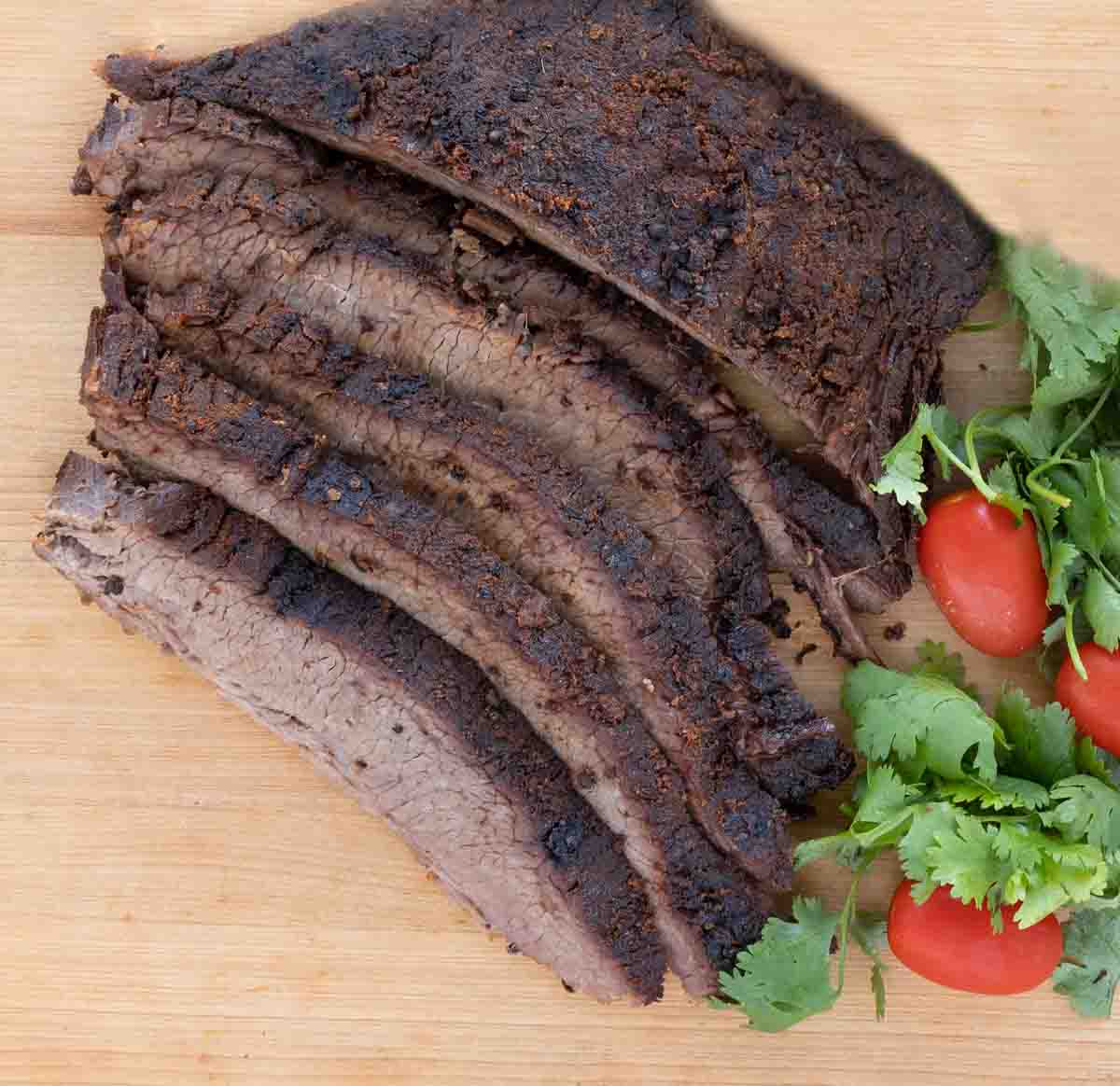
I love barbecue, and for years, I was afraid of making the different cuts of meat I enjoyed eating at my favorite bbq joints.
But at the suggestion of a grill master friend, I learned the secrets of dry brining and slow-roasting meats in my oven. And that is how I came up with my oven roasted beef brisket recipe.
If you prefer using your slow cooker, you’re going to love my Slow Cooker Beef Brisket Recipe.
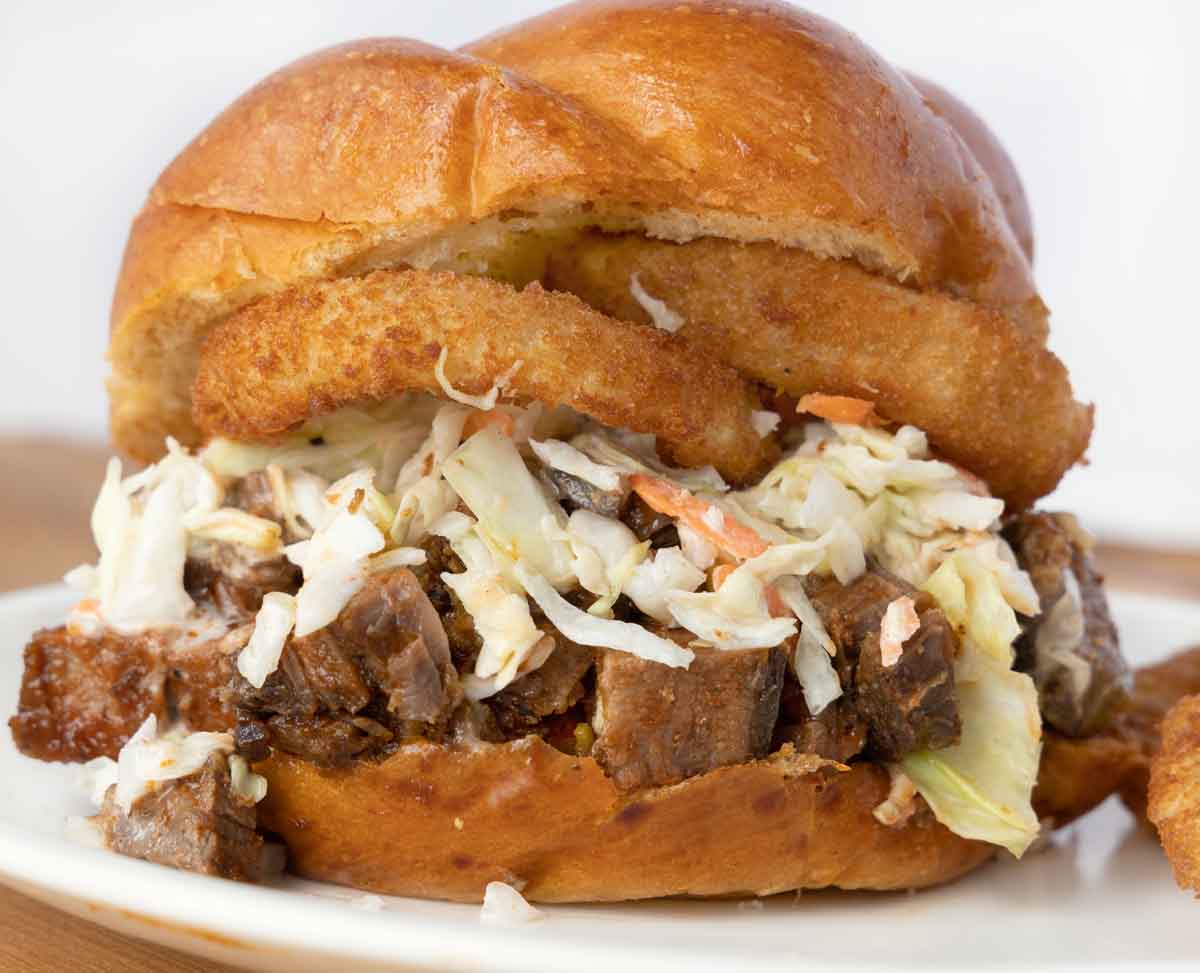
I love a good brisket sandwich, and one of the places I frequent for barbecue makes a delicious combination by adding coleslaw and onion rings to chopped brisket covered in bbq sauce served on a toasted brioche bun.
You’re going whole hog with this sandwich!
What ingredients do I need to make an oven-baked beef brisket?
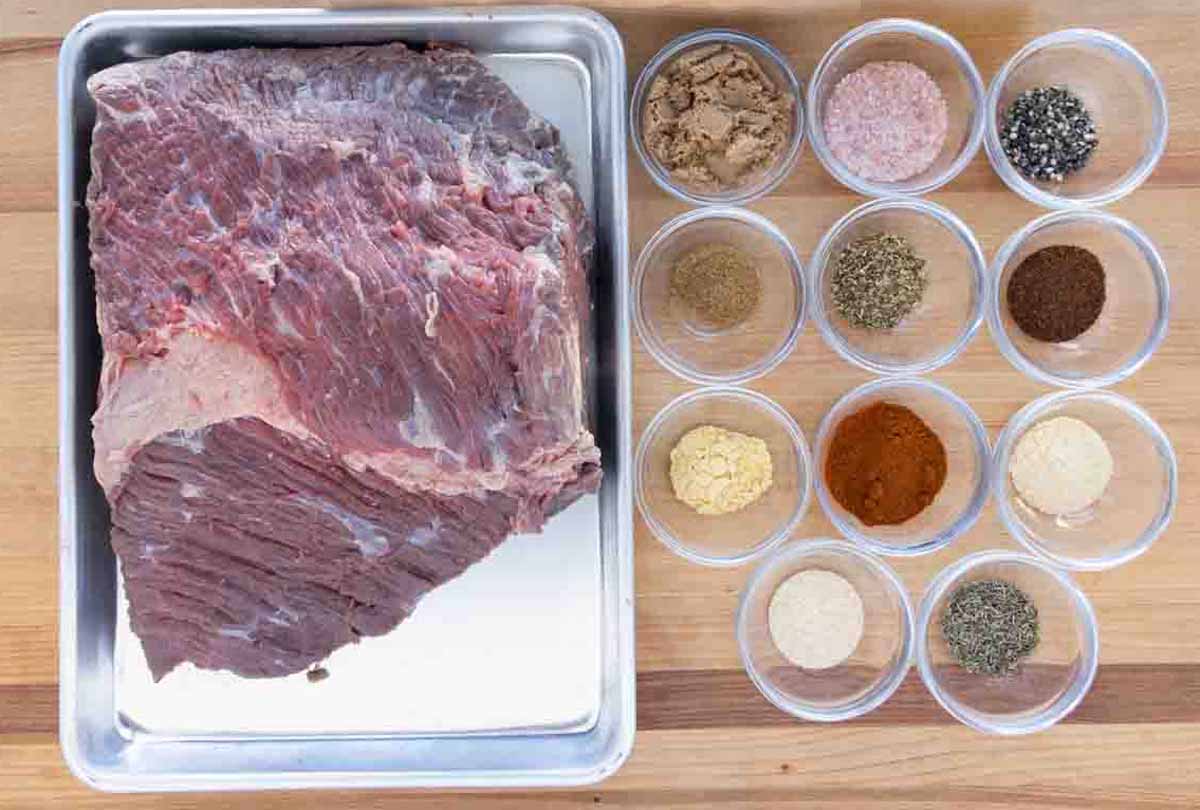
Let’s start by gathering the ingredients we need to make a dry rub oven-baked brisket. In Chef Speak, this is called the “Mise en Place,” which translates to “Everything in its Place.”
Not only does setting your ingredients up ahead of time speed up the cooking process, it also helps ensure you have everything you need to make the dish.
What are the different cuts of Brisket?
Brisket comes in three different cuts. A full-packer brisket is a whole brisket that includes both the point and flat sections. It will weigh anywhere from 8 to 12-plus pounds.
The point cut is the fatty part of the brisket, also known as the deckle or second cut. The flat is the leaner cut of the brisket and is also known as the first cut.
Whether you use the whole brisket, a flat, or the point, this recipe will still yield a moist, tender, OMG flavorful brisket.
*For my oven-roasted beef brisket recipe, either the flat or the point will work. Most grocery stores will carry the flat.
How do I prepare the brisket for slow roasting?
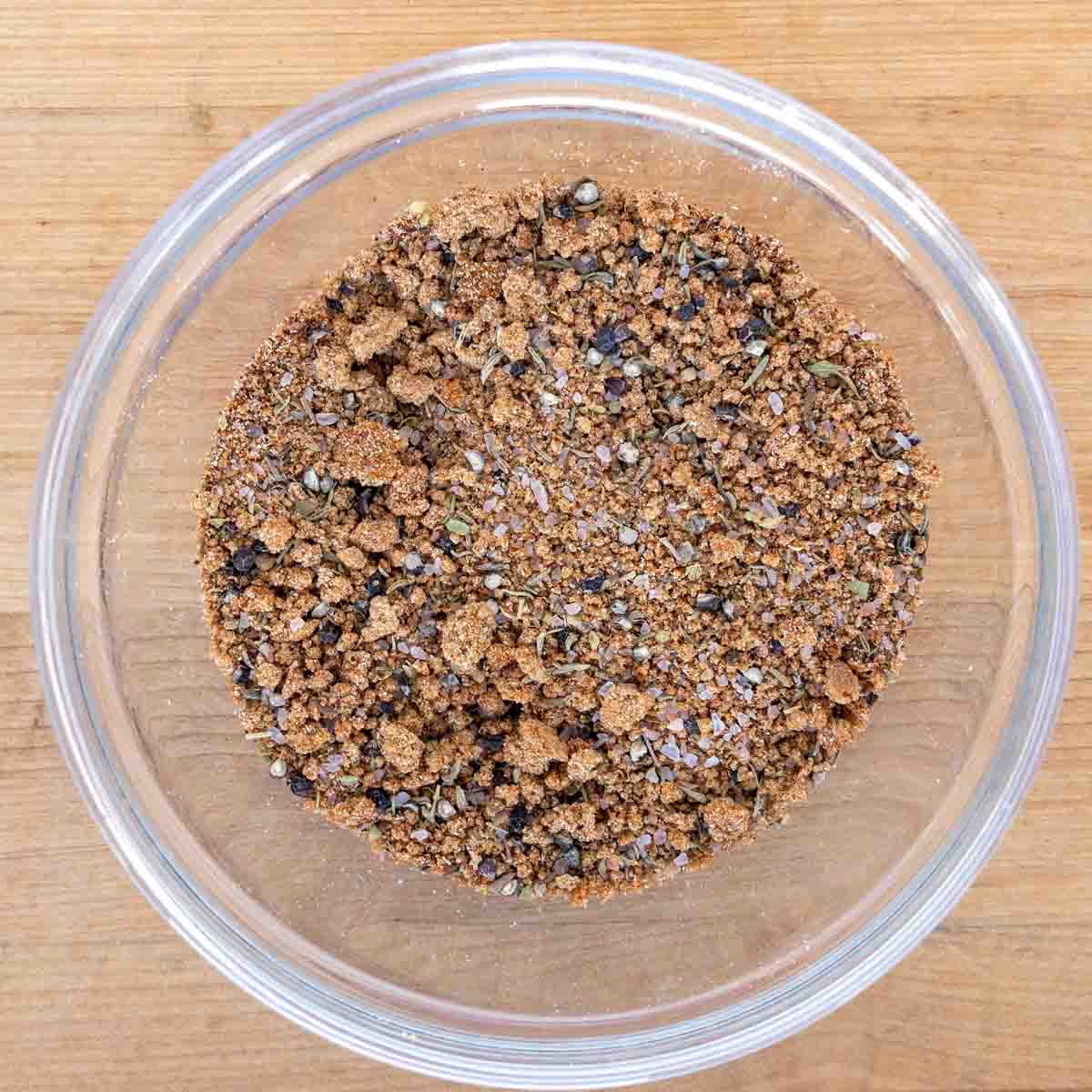
The first step is preparing the dry rub, which will act as brine, adding flavor and helping to keep the brisket moist.
*My spices include onion powder, garlic powder, brown sugar, chili powder, sea salt, cracked black pepper, and a few others. Feel free to adjust the seasonings to your taste.
How do I make an oven-baked beef brisket?
Start by trimming the brisket of any silver skin and if needed removing most of the fat cap from the top of the brisket. Hard fat does not render!
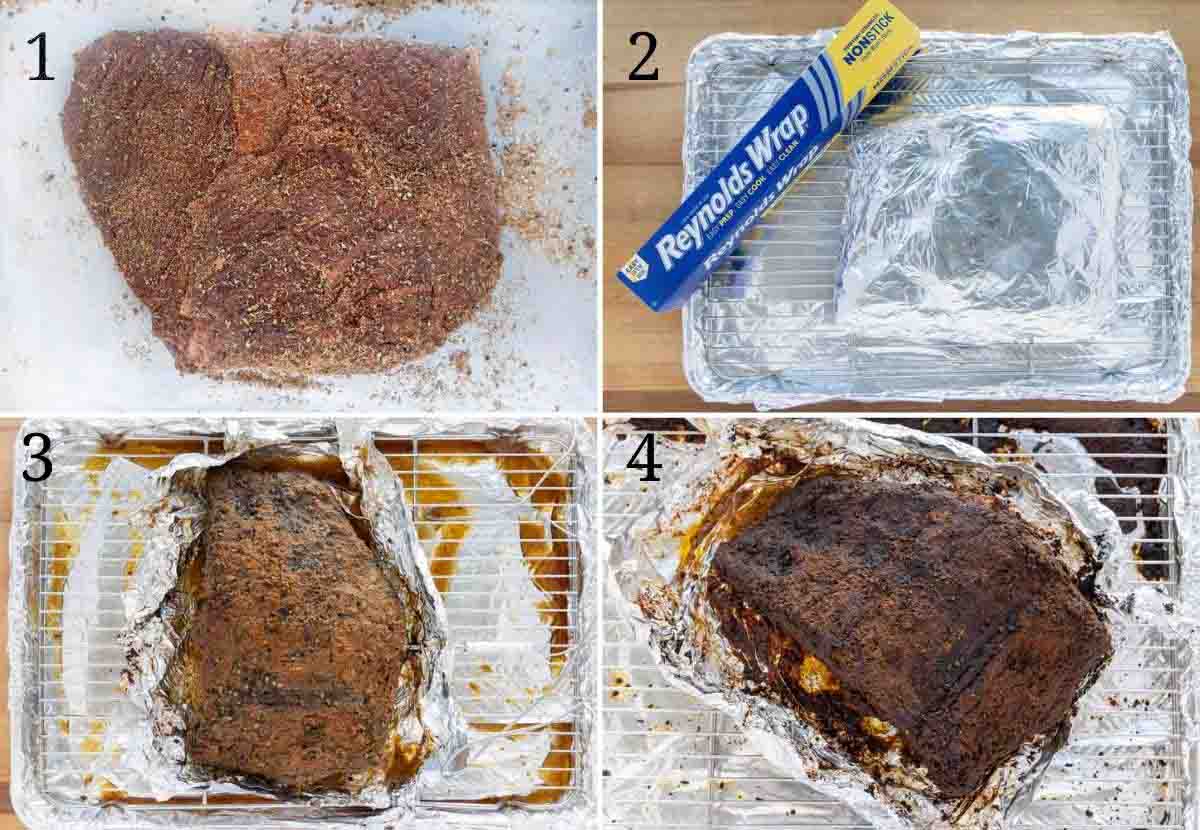
- Pat the brisket dry with paper towels and coat the entire brisket with the dry rub, massaging the dry rub into the meat. Make sure to coat the sides of the brisket.
- Wrap the dry-rubbed brisket tightly with foil and refrigerate overnight. *A minimum of 3 hours is needed for the dry rub to penetrate the brisket.
- Take the brisket out of the refrigerator an hour before cooking, allowing the brisket to get close to room temperature before cooking.
- Preheat the oven to 275° F
- Insert an oven-safe meat thermometer into the thickest part of the brisket. The fat side should be up during the roasting process.
- Slow Roast in the oven until the internal temperature reaches 175 degrees F.
- Remove the brisket from the oven and carefully cut the foil open to expose the brisket, and continue roasting until the internal temperature reaches 195-205 degrees F.
Chef Dennis Tip:
Do not be tempted to raise the temperature for faster cooking time, or your brisket will be very tough. Slow oven roasting using a low temperature allows the fats to break down gradually, tenderizing the beef, so it has a stretching juicy quality in the end.
How do I slice oven-baked brisket?
Place the beef brisket on a cutting board and let it rest for an hour before slicing. Slices should be pencil-width thick.
Allowing brisket to rest lets juice redistribute throughout the meat. If sliced right off the grill, the meat would lose moisture.
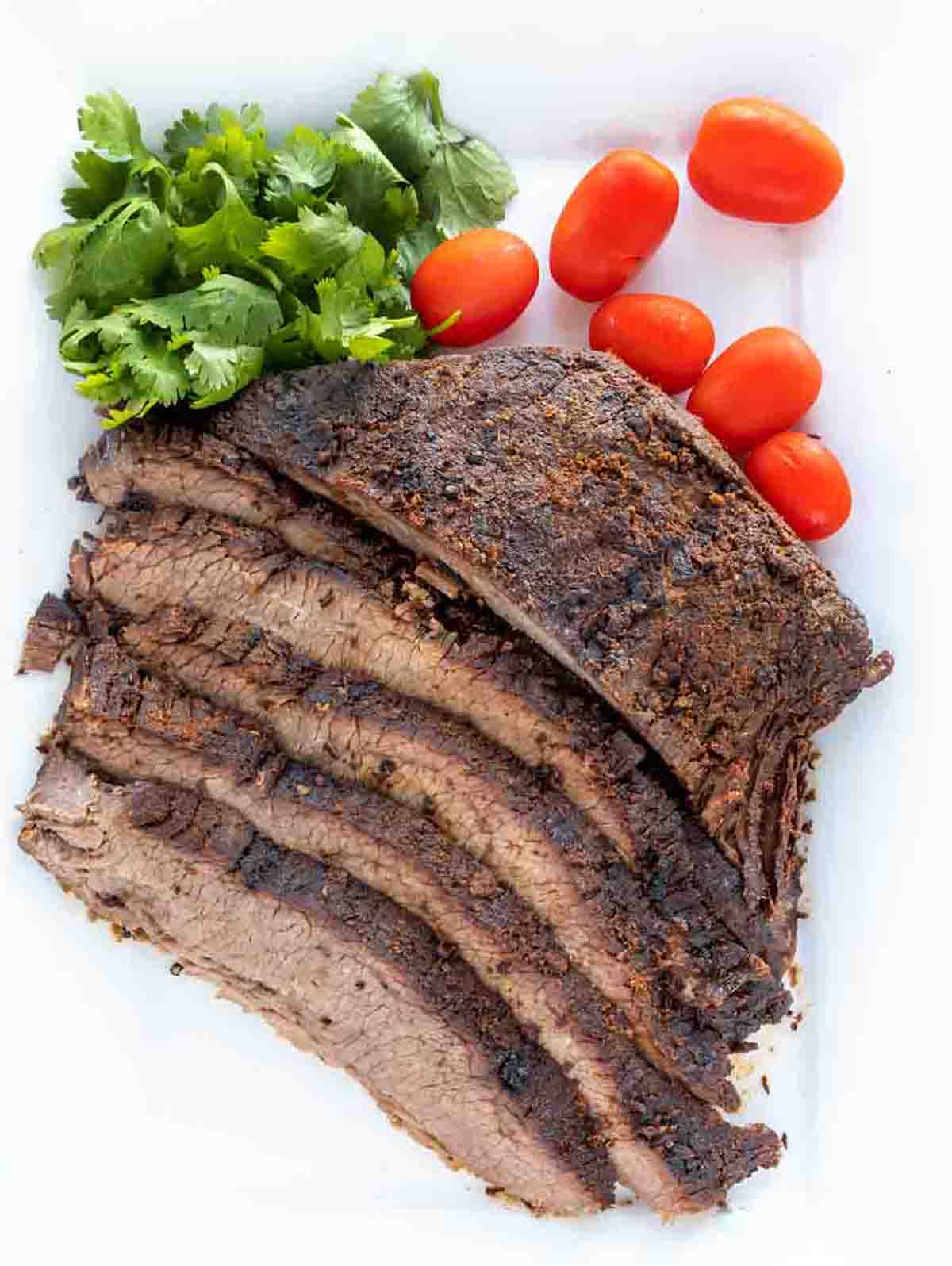
After the brisket has rested, the next step is finding the grain. The direction of the cut is key to having tender fall-apart slices of brisket.
You want to slice against the grain. The grain of any meat is the alignment of the muscle fibers. When you cut with the grain, the muscle fibers remain somewhat intact and result in meat that is tough and difficult to chew. When you cut against the grain, you break up the muscle fibers evenly so that the meat becomes much more tender and easy to chew.
Chef Dennis Tip:
Before cooking, find the grain and slice a corner of the flat. This will make it easier to find the direction of the grain when the brisket is done and ready to be sliced.
How can I use leftover oven-cooked beef brisket?
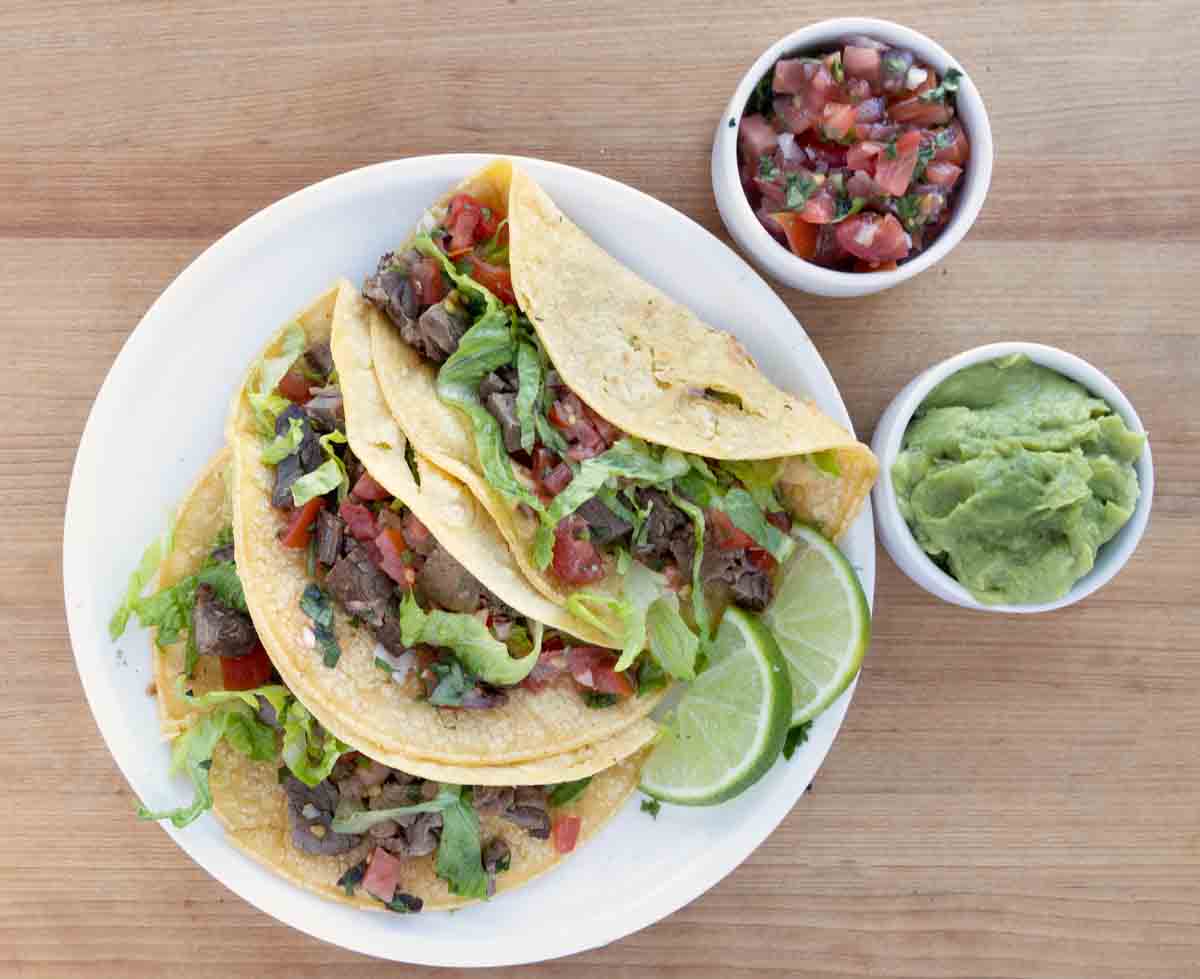
You’ll often find chopped brisket used in tacos, sandwiches, and chili. Other delicious uses for leftover brisket are in brisket hash, soups, stews, quesadillas, topping on pizza, and brisket and beans, to name a few.
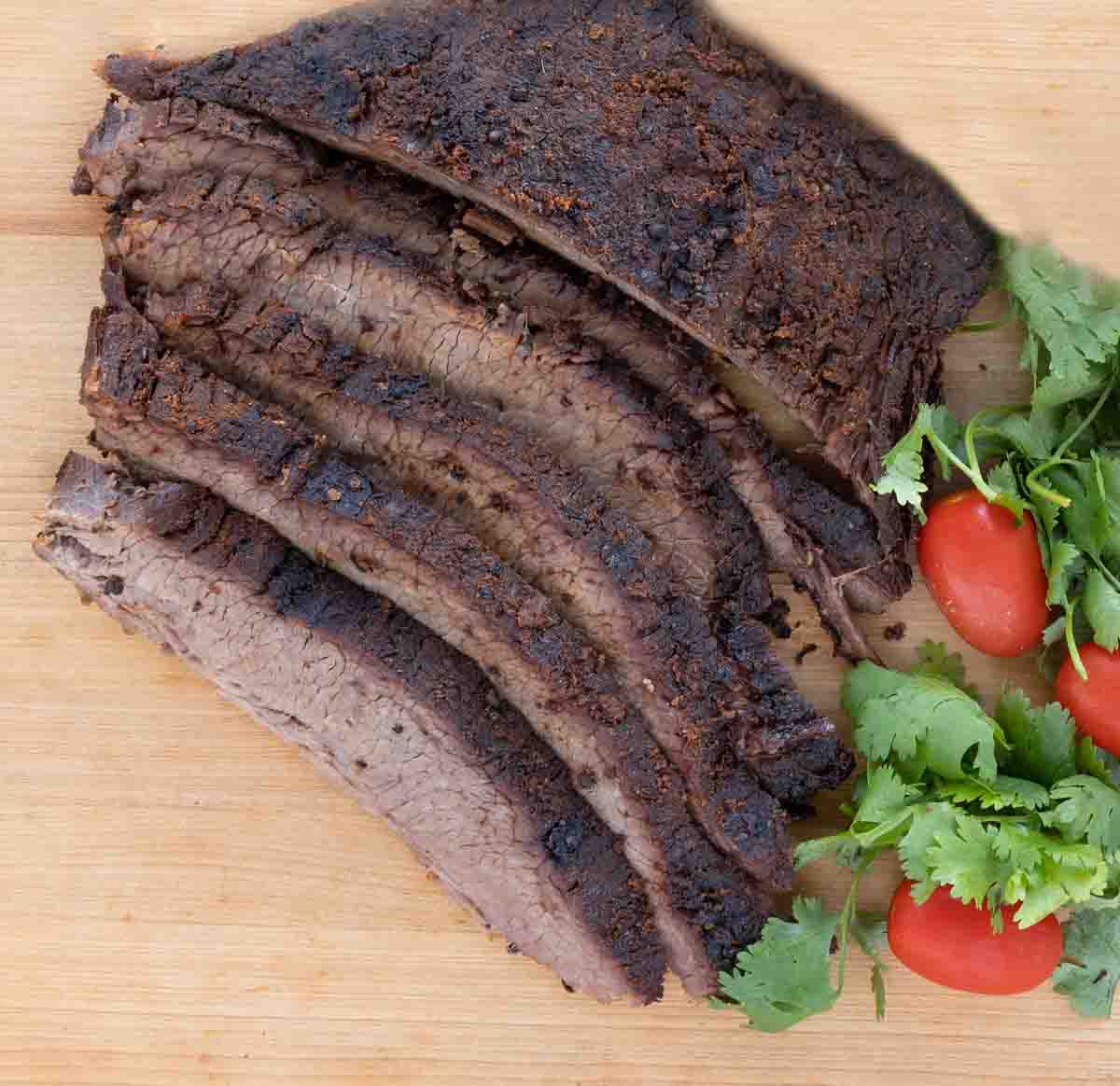
Wouldn’t your friends and family love to sit down to this tender, delicious dry-rubbed oven-roasted brisket? Why not surprise them and let them think you’re the new grill master in the family?
Recipe FAQ’s
If you rub the brisket with the spice mixture and immediately place it in the oven, it’s just a rub. It will flavor the exterior of the meat, and the spices will penetrate a little way into the beef.
But if you rub the seasonings into the brisket and let it sit overnight before roasting, this would be considered a brisket dry brine. The salt and other seasonings will have time to truly work their way into the center of the beef, giving you a more flavorful piece of meat.
Brisket is a tougher cut of meat, and that means it needs to be slow-roasted to a higher temperature internally before the fats start to break down and tenderize the meat. The magic starts to happen at 195 degrees and can continue to cook up until 205 degrees.
A good rule of thumb is to cook the brisket for 60 minutes per pound at 275 degrees F. Of course, this all depends on your oven. Make sure to give yourself extra time just in case it hasn’t reached the optimal internal temperature range of 195 -205 degrees F.
To get a fork-tender brisket, the maximum cooking temperature is 300 degrees F. Any hotter will produce a tough brisket. Brisket needs a slow roast, and the sweet spot for roasting is 250-275 degrees F.

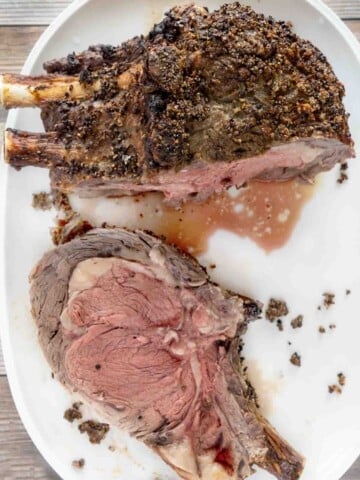
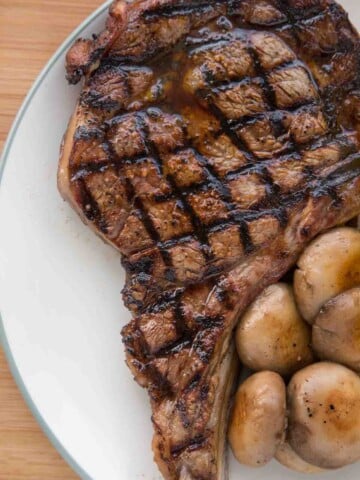
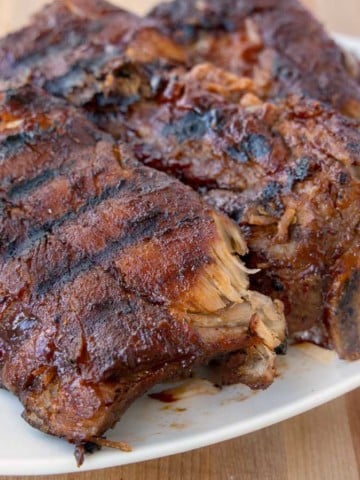
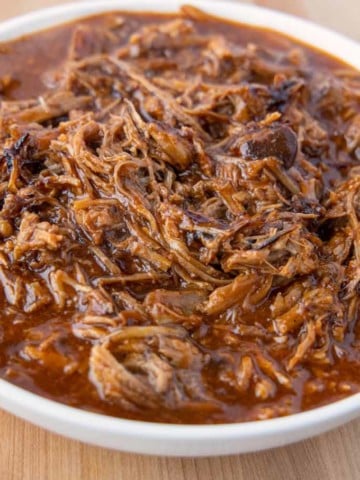
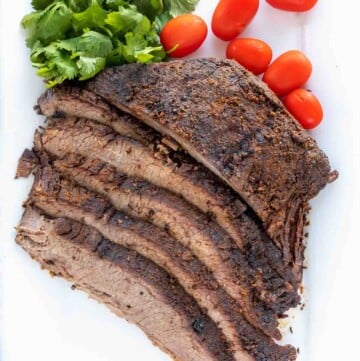
Nat says
I have a 10lb point cut brisket. How long should I cook it for? And if I just wanted to make it a smaller brisket is it wise to just cut off a piece of the thinner end to make it to say, make it 8 lbs? (I would not be using the 2lb cut piece for this recipe). how long would you cook an 8lb point cut?? Thanks for the help! First time doing this!
Chef Dennis Littley says
It would take 9 – 12 hours for it to cook. You’re cooking for temperature so its hard to pinpoint the exact amount of time.
You could definitley cut the smaller end off, and it will take about 1 hour to 1 1/4 hours per pound so that would be 8-10 hours.
Maxine Derkatch says
My husband (age 79) said unprompted that it was the best brisket he ever had!
Chef Dennis Littley says
That is high praise indeed! Thank you for the great review and comment.
Chandra says
Do you roast with fat side up or down?
Chef Dennis Littley says
Fat side is always up when roasting meats.
Lee says
I am using your recipe for the first time for a packer brisket, how do you recommend re-heating to keep it juicy and should I slice it or keep it whole for the reheating?
Chef Dennis Littley says
Keep it whole to reheat. To reheat, place it in a baking dish with a little broth, apple juice, or water. Cover with foil, and place in a 325 degree oven to reheat to your desired temperature.
Monica L Robl says
I made this recipe exactly as the chef instructed. It came out perfectly. We ate it all in one evening. Try it!
Chef Dennis Littley says
I’m happy to hear you enjoyed the brisket, Its a family favorite and we have it often.
Ben R. says
I prepared and cooked a brisket using this recipe and the family and I enjoyed it immensely. We will be preparing and cooking this again!
The brisket was moist, tender, and flavorful, and the drippings made really great gravy (thickened with flour, nothing additional).
Thank you, Chef.
Chef Dennis Littley says
You’re very welcome and I’m happy to hear you enjoyed the brisket!
Jen says
Thank you!! This was so easy and so delicious it got rave reviews from people who love real BBQ brisket.
Chef Dennis Littley says
Thanks for letting me know you enjoyed the brisket, I’m happy to hear it met with approval from true bbq afficinados!
Carol says
I always make “Labor Day” brisket. I tried your recipe last year and my brisket came out perfect. This time I didn’t have great luck! Can you tell me what I may have done wrong.
Using new oven safe thermometer I inserted and put the meat in oven. Anticipated my brisket being almost 5 lbs would take at least 4 hours.
(Oven temp remained constant 275)
After 2 hours I checked the temp and the thermometer temp had already reached 180 degrees. I thought that was a bit quick because at this point I should unfold the foil and let it continue cooking (actually was supposed to be 175).
After another hour instant read thermometer was all over 190, 200 in another area another area 198.
Is it possible a 5 lb could take only 3 hours. I honestly didn’t know if I should trust the thermometers at this point and kept it in a bit longer. It came out drier than I would have liked but still of course very delicious.
Thanks for your help!!
Chef Dennis Littley says
It is entirely possible, and you just have to go by the internal temperature you’re getting. It is also possible that last you got the point cut which is thicker and fattier. The flat is more common in grocery stores but is a leaner cut and more prone to drying out.
Carol says
Thank you so much!
Can I ask butcher to cut a 5lb point cut??
Sheri says
OMG! This is the first brisket I’ve ever made. I was a bit intimidated but figured what the hey! It was absolutely delicious. I’ll definitely make this again and again. So simple, low and slow.
Chef Dennis Littley says
Thank you so much for letting me know you enjoyed my brisket recipe, and that your first attempt at making brisket was a good one.
Nina says
The meat was tender and fell apart.
Chef Dennis Littley says
I’m happy to hear that it turned out great!
Lori says
I thawed my brisket out overnight and did the dry rub according to the recipe. I did not have time to let it sit so I dropped it straight into the oven as soon as I rubbed it and it turned out perfect.
Chef Dennis Littley says
I’m happy to hear you enjoyed the brisket. If you have time to let it sit a bit with the seasonings it will be even better!
Donna says
Hi Chef,
I made this and it was awesome however a little dry. Any tips for me there?
Chef Dennis Littley says
Sometimes the flat part of the brisket can be very lean, which can make it dry. You can make a compound butter to top the brisket with which will add some fat into the meat. You can also try adding a water pan in the bottom of the oven to keep some moisture in the oven as it cooks.
You may want to look for a point brisket which is the fattier section of a brisket, that will come out more moist because of the fat.
Sharon says
Chef Dennis,
If I can’t find beef brisket. Can you recommend another type cut of meat?
Thank You
Chef Dennis Littley says
A chuck roast is similar, it won’t be quite the same but can be cooked in the same method. Just make sure to use an oven thermometer to get it ot the right temperature.
Sharon Stark says
Hi Chef Dennis,
5lbs is to much for just my husband and me. So thinking 3lbs. Would cooking time still be same?
Thank you,
Chef Dennis Littley says
A 3 pound brisket will probably take about 4 hours. Just make sure to use an oven thermometer to get the brisket to that magical temperature of 195-205.
Jacqui says
How exactly do you do a temperature check on the meat? Do you wait until the cooking time is about where you think it should be, then unwrap the brisket and probe it? If the temperature isn’t where it should be, then wrap it back up and allow to cook longer?
Should the meat thermometer have been inserted and wrapped up in the foil with the meat? I didn’t do that as I didn’t see it in the video. I’m planning on using my instant read probe, but want to know when to start checking and if it’s okay to unwrap the meat when you don’t know if it’s actually ready to unwrap.
My brisket is in the oven now and has been for about 3 hours.
Chef Dennis Littley says
stick the probe right thru the foil to check the temperature. Ideally you would insert a meat thermometer into the meat before roasting.
Jacqui says
Thanks for your help! The brisket was highly praised by my family.
2 questions for next time:
So with the thermometer, do you stick it in the raw meat then wrap it and the meat inside the foil, or do you wrap the meat, then stick the thermometer in through the foil?
My (6 lb) brisket seemed to hit what other recipes call the stall at 180 degrees. It sat at that temp for 3 hours (at least, because after that amount of time, I just went ahead and took it out because it had been cooking a total of 10 hours by then. I let it sit wrapped in a cooler for an hour after that). I had initially opened up the foil as per instructions when it hit 180, but then decided to cover it back up as the temperature wasn’t budging. It ended up fine, but I was wondering how you’d have handled it.
Chef Dennis Littley says
I’m happy to hear you enjoyed the brisket. Wrap the meat, then stick the thermometer in through the foil. That way you can see it. If it does hit a stall, which I have had happen, rewrap it in foil until it starts to climb again. It doesn’t always happen, but when it does its a real pain!
Robyn Adkins says
I have a couple of questions, I looked through other questions that were already answered but I just want to make sure I understand. I have a 3 pound “point market trim” brisket. So this is a more fatty cut, right? Anything that I should modify or keep an eye out for this cut? I think I use half the spice mixture? My oven has a bake function and a convection roast, I think I should do convection roast? If I want a crispy-ish top, could I broil at the end of cook time or will this try it out?
Chef Dennis Littley says
Yes,it is a fattier cut which is a good thing. That means as it cooks the fat will keep the brisket moist. There is no need to do anything different. You can cut the seasoning down by 1/3. Convection roast is good for cooking the brisket. You can broil it to crisp up the top, but that’s not something that is usually done with a brisket.
Carrie says
If using convection setting, would you recommend keeping the recipe cooking time, or altering? Thank you; this looks delicious and will be my first try for beef brisket- going for a bit of an unconventional Thanksgiving meal this year.
Chef Dennis Littley says
Convection is pretty much all I use, its sort of become the standard, especially with meats. It’s more even cooking. The time should be the same, but remember you’re cooking to temperature, not necessarily time. I would plan on having it done at least an hour ahead of time, tent it with foil and let it sit. That will really give it time for the juices to redistribute into the meat.